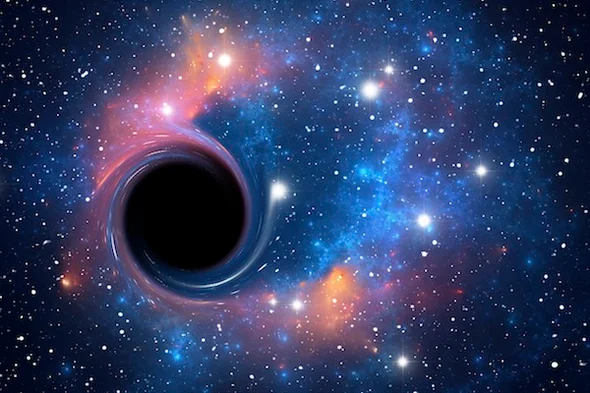The universe is full of mysteries and wonders. Scientists discovered a black hole close to the earth.
Indeed the university has got loads of mysteries out there but no other cosmic phenomenon is perhaps quite as fascinating as black holes, locations where gravity is so strong that they twist the very nature of the space and time around them — so strongly that not even light can escape their pull.
Black holes are the remnants of long-dead stars. Their name comes from the fact that not only do they emit no light, but they also absorb all light that falls into them. Because of this, they are invisible. “Black holes” is a literal name for these cosmic ninjas, which are undetectable in the way that we see other stars.
Did you know that the closest black hole to Earth exists in our own cosmic backyard? Recently, astronomers discovered a black hole, ten times the size of the Sun, and have named it Gaia BH 1.
The researchers used the Gemini North telescope in Hawai’i, at the International Gemini Observatory.

Researchers reported that Gaia BH1 is located about 1600 light-years away in the constellation Ophiuchus. The next nearest known black hole is about 3,000 light-years away in the constellation Monoceros.
An important fact to be noted is that this black hole is dormant, a silent killer waiting for the currents of space to feed it.
“Take the Solar System, put a black hole where the Sun is, and the Sun where the Earth is, and you get this system,” explained Kareem El-Badry, an astrophysicist at the Center for Astrophysics | Harvard & Smithsonian and the Max Planck Institute for Astronomy, and the lead author of the paper describing this discovery.
“While there have been many claimed detections of systems like this, almost all these discoveries have subsequently been refuted. This is the first unambiguous detection of a Sun-like star in a wide orbit around a stellar-mass black hole in our Galaxy.”
The other stellar-mass black holes were revealed by their energising interactions with a companion star, despite the fact that there are probably millions of them roaming the Milky Way Galaxy. Superheated material from a nearby star spirals in toward the black hole, where it produces intense X-rays and material jets. When a black hole is dormant (i.e., not actively feeding), it simply merges into its surroundings.”I’ve been searching for dormant black holes for the last four years using a wide range of datasets and methods,” said El-Badry. “My previous attempts — as well as those of others — turned up a menagerie of binary systems that masquerade as black holes, but this is the first time the search has borne fruit.”
Data from the Gaia spacecraft of the European Space Agency were initially examined by the researchers to determine the system’s potential presence of a black hole. Gaia captured the minuscule deviations in the star’s velocity brought on by a huge invisible object.
El-Badry and his team used the Gemini Multi-Object Spectrograph instrument on Gemini North to study the system in greater detail. This device accurately determined the companion star’s orbital period by measuring the companion star’s velocity as it circled the black hole. The team identified the central body as a black hole around 10 times as massive as our Sun thanks to the Gemini follow-up observations, which were essential in putting constraints on the orbital velocity and, consequently, masses of the two components in the binary system.
“Our Gemini follow-up observations confirmed beyond reasonable doubt that the binary contains a normal star and at least one dormant black hole,” elaborated El-Badry. “We could find no plausible astrophysical scenario that can explain the observed orbit of the system that doesn’t involve at least one black hole.”
As they only had a small window to conduct their follow-up observations, the team relied not only on Gemini North’s excellent observational capabilities but also on Gemini’s capacity to deliver data on short notice.
“When we had the first indications that the system contained a black hole, we only had one week before the two objects were at the closest separation in their orbits. Measurements at this point are essential to make accurate mass estimates in a binary system,” said El-Badry. “Gemini’s ability to provide observations on a short timescale was critical to the project’s success. If we’d missed that narrow window, we would have had to wait another year.”
The unique configuration of the Gaia BH1 system is difficult to explain using astronomers’ current concepts of the evolution of binary systems. The progenitor star, which later evolved into the newly discovered black hole, would have had a mass at least 20 times that of the Sun.







